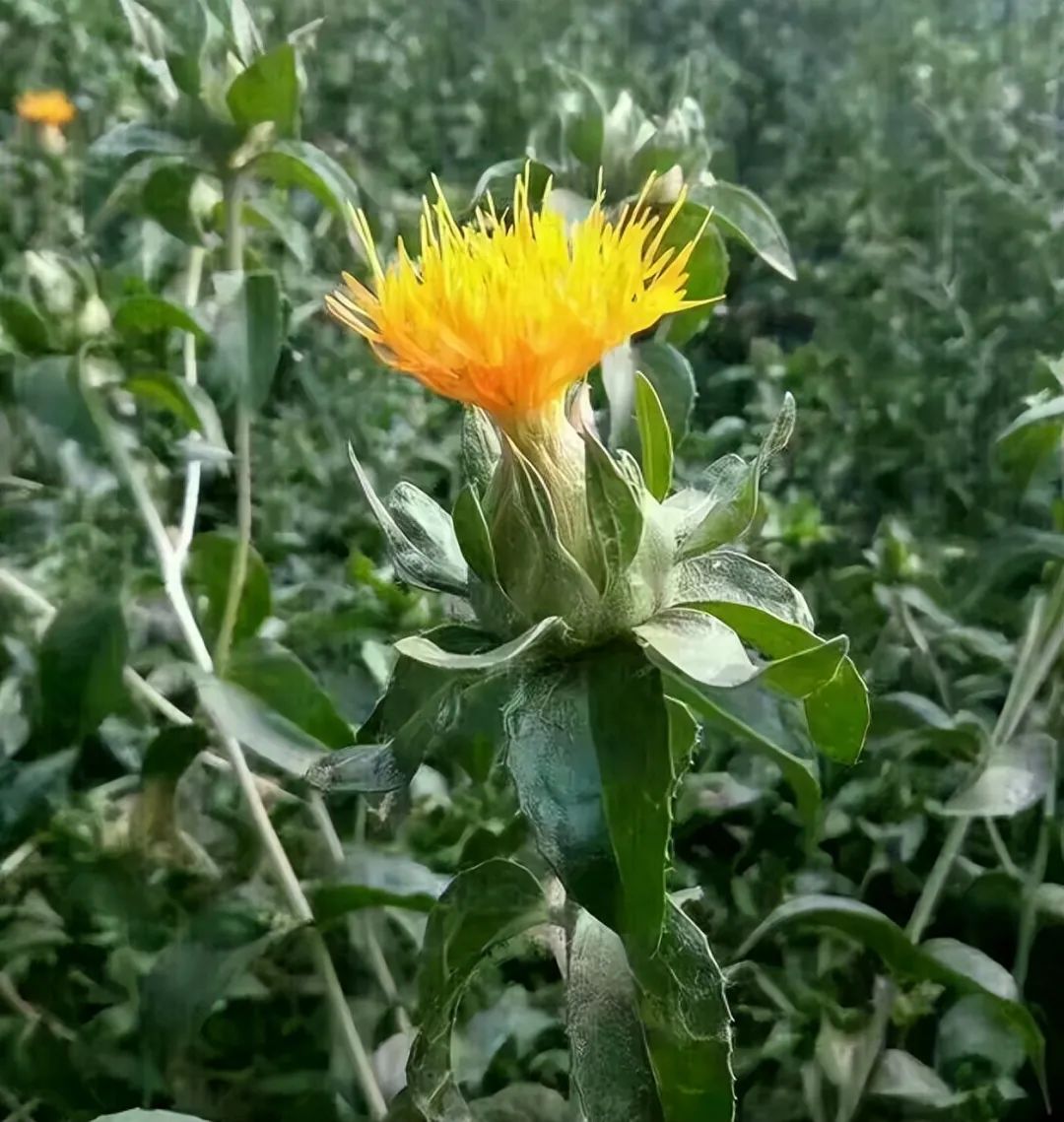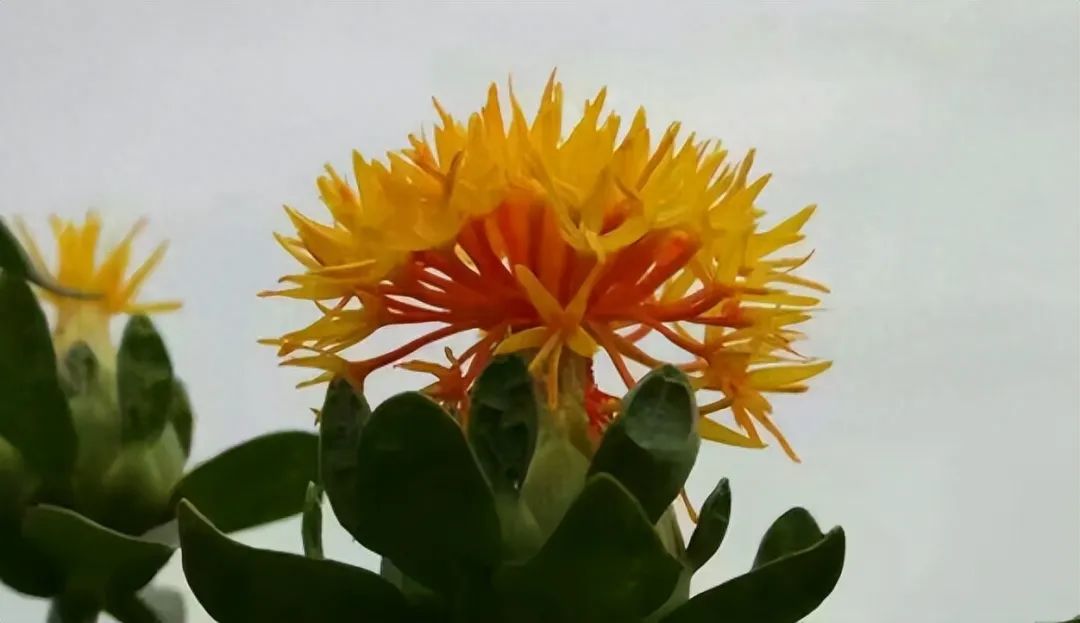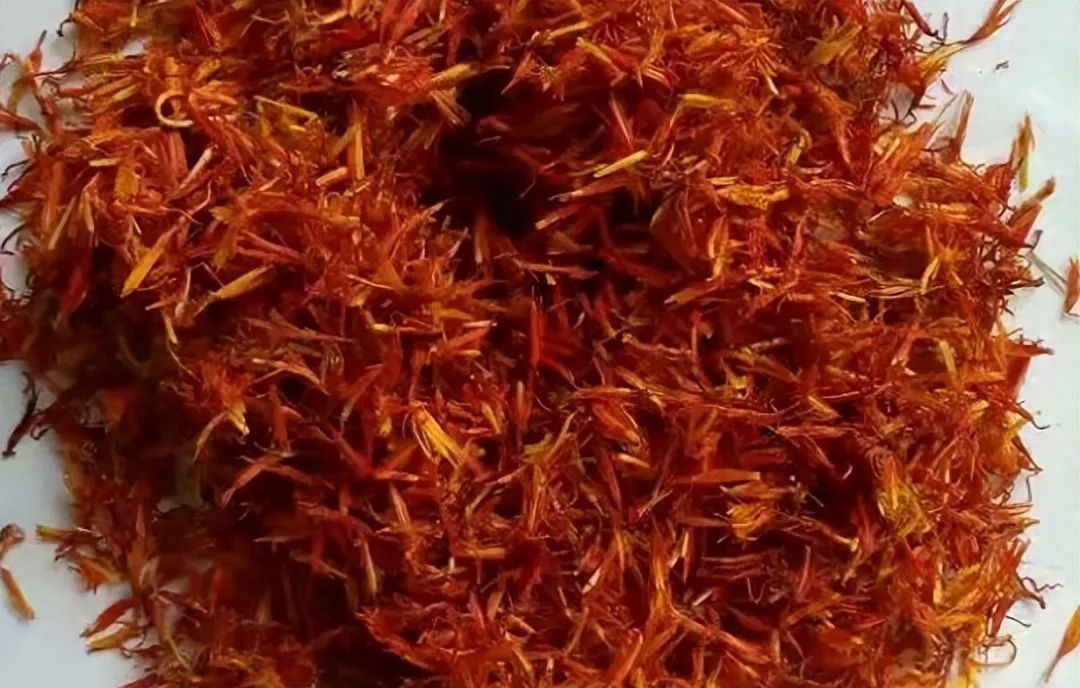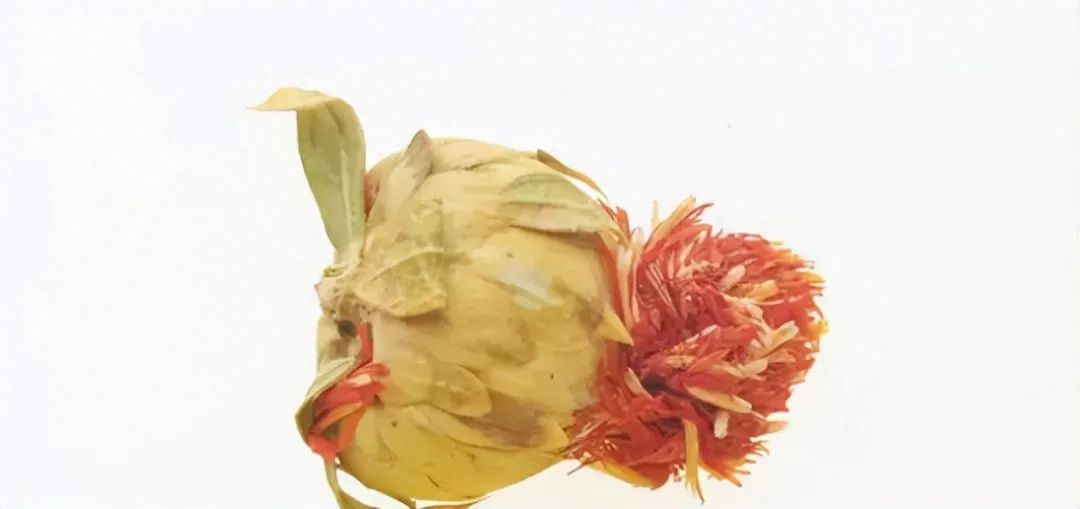Click on "Complete Herbal Encyclopedia" above...
Disease inquiry, health guidance, classic wellness, Traditional Chinese Medicine (TCM) and herbal medicine, no need to seek help when ill.
Safflower (Honghua) is the dried flower of the plant Carthamus tinctorius L., belonging to the Asteraceae family. The flowers are harvested in summer when they change from yellow to red, and then dried in the shade or under sunlight.

Safflower Plant

Safflower
【Characteristics】 This product consists of tubular flowers without ovaries, measuring 1-2 cm in length. The surface is reddish-yellow or red. The corolla tube is elongated, with five lobes at the tip, and the lobes are narrow and 5-8 mm long; there are five stamens, and the anthers are fused into a tubular shape, yellowish-white; the stigma is long and cylindrical, with a slightly bifurcated tip. The texture is soft. It has a faint fragrance and a slightly bitter taste.

Safflower Medicinal Material

Safflower Flower Head

Safflower Identification
Summary of identification of genuine and counterfeit safflower:
1. Color: Good quality safflower is bright and vibrant, with few mixed colors.
2. Texture: Good safflower feels soft, while inferior safflower feels rough. It is essential to have a comprehensive understanding of genuine products for comparison. (Note: The roughness mentioned refers to counterfeit products that have been adulterated; however, safflower from Yunnan may also feel hard and have a whitish color, giving the impression of being underdeveloped, so be cautious in distinguishing.)
Adulteration techniques exposed:
1. Sugar water: Identification method: 1. Grab a handful of safflower and rub it; it feels sticky. 2. Taste it; it is sweet.
2. Alum water: Similar identification method as sugar, mainly based on appearance and taste.
3. Fine salt: Identification method: taste it; it is salty, and upon close observation, white particles can be seen.
4. Sand: Adulterers often mix very fine sand into the flowers, claiming it is due to the sandy conditions of Xinjiang, but it is usually intentional.
5. Wood chips: Since safflower often contains some fragments, this type of adulteration can be easily overlooked.
6. Moisture: Spraying water is a common method to increase weight, which can generally be identified by texture.
7. Dyeing: Other flowers may be dyed and mixed, and it is also possible that extracted safflower is dyed again and mixed with good safflower.
8. Edible oil: After mixing, the flower color darkens and has a slight oily smell (it is necessary to frequently smell genuine safflower). Identification method: 1. Grab a handful of flowers and rub them; oil spots will appear on your hands. 2. Soak in boiling water; oil droplets will be visible on the surface. Some pharmaceutical factories have used this type of safflower, and during the material input, an oily layer was observed on the liquid surface, indicating the extent of adulteration.
9. Chemical fertilizer urea: Generally, the fertilizer is dissolved in water and sprayed on. Flowers treated this way appear dry but feel damp when squeezed. Identification method: 1. Careful observation will reveal white particles, which are fertilizer crystals. 2. Safflower mixed with fertilizer appears grayish-yellow.
10. Adulterated materials: These are processed safflower used by unscrupulous vendors to increase weight.
【Chemical Composition】
Contains carthamin, neocarthamin, carthamone, safflower polysaccharides, palmitic acid, cinnamic acid, and lauric acid.
【Pharmacological Effects】
① Effects on the uterus
The decoction has excitatory effects on the isolated and in situ uteri of mice, guinea pigs, rabbits, dogs, and cats, but is weaker than that of saffron decoction. Early reports on the pharmacological studies of safflower were based on unverified varieties, and many results remain uncertain.
② Effects on the circulatory system
The decoction has properties similar to saffron decoction, causing hypotension and cardiac inhibition in anesthetized animals, but to a lesser extent. In isolated rabbit ear specimens, it has a vasoconstrictive effect. The water-soluble portion of the coronary heart formula No. 2 (Dan Shen: Safflower: Chi Shao: Chuan Xiong: Jiang Xiang = 2:1:1:1:1) has a dilating effect on the coronary artery (measured by an electromagnetic flowmeter) and femoral artery in dogs; its water decoction administered to rats for four consecutive days had no effect on myocardial ischemia induced by posterior pituitary extract. Additionally, a 10 mg/kg intravenous injection of safflower aqueous extract increased coronary flow in anesthetized dogs (measured by the coronary sinus catheter method) to a certain extent. The aqueous extract had no significant effect on blood pressure, while the ethanol extract (100-300 mg/kg) could lower blood pressure. It also enhanced the hypoxia tolerance of mice (by placing mice in a 250 ml sealed wide-mouth bottle and observing the time until death).
③ Other effects
In rabbits with hypercholesterolemia, oral safflower oil at 1 g/kg/day can lower serum total cholesterol, total lipids, and triglycerides. Oral administration of coronary heart formula No. 2 extract (10 ml/each/day) significantly reduced serum cholesterol, neutral fat, and β-lipoprotein levels in experimental atherosclerotic rabbits, and also lowered the total cholesterol and total lipid content in the aortic wall. The area and thickness of atherosclerotic plaques in the aortic intima, as well as lesions in the anterior descending branch of the coronary artery and small intramyocardial arteries, were alleviated, indicating a tendency for plaque regression, although biochemical and morphological observations did not show significant statistical differences. Safflower oil can also stimulate certain smooth muscle organs such as the small intestine and bronchi. The coronary heart formula No. 2 has an inhibitory effect on isolated rat ileum and can antagonize intestinal spasms induced by acetylcholine. The toxicity of safflower is much lower than that of saffron: when mice were fed a diet containing 6% safflower powder for over a month, no weight loss was observed; however, when increased to 8-10%, weight loss occurred, and at 15%, it caused death; while saffron mixed at 2% could lead to weight loss in mice after one month, with increased amounts resulting in death.
【Properties and Channels】 Pungent, warm. Enters the Heart and Liver meridians.
【Functions and Indications】 Invigorates blood circulation, regulates menstruation, disperses blood stasis, and alleviates pain. Used for amenorrhea, dysmenorrhea, retained lochia, abdominal masses, chest pain, stasis abdominal pain, stabbing pain in the chest and hypochondrium, trauma from falls, and painful sores.
【Dosage and Administration】 3-10 g.
【Precautions】 Use with caution in pregnant women.
【Storage】 Store in a cool, dry place, protected from moisture and pests.
Note: This article is for reference only; specific treatment and medication should follow medical advice! This public account is used for academic exchange only.
To learn more about TCM, medicinal herbs, herbal recipes, and folk remedies, ▼ Click the card below ▼ to inquire!
For example: low back pain, gynecology, andrology, kidney tonification, lumbar disc herniation, back pain, leg pain, knee pain, cervical spondylosis, liver disease, stomach disease, constipation, frequent urination, diarrhea, abdominal protrusion, dysmenorrhea, mammary gland hyperplasia, postpartum care, acne, white hair, hair loss, skin diseases, age spots, aging, yin deficiency, colds, coughs, fever, insomnia, stones, pharyngitis, sore throat, headaches, toothaches, snoring, oral ulcers, bad breath, rhinitis, tinnitus, eye diseases, thyroid issues, dandruff, athlete's foot, hemorrhoids, cold hands and feet, rheumatism, night sweats, cerebral hemorrhage, hypertension, diabetes, asthma, heart disease, cardiovascular diseases, fatty liver, gout, dementia, varicose veins, qi tonification, blood tonification, calcium supplementation, weakness, obesity, pediatric diseases, slim legs, slim waist, dampness, spleen strengthening, hiccups, body odor, cramps, smoking cessation, meridians, Chinese patent medicines, foot baths... and more.
Thank you for sharing and clicking to view, may good fortune be with you!